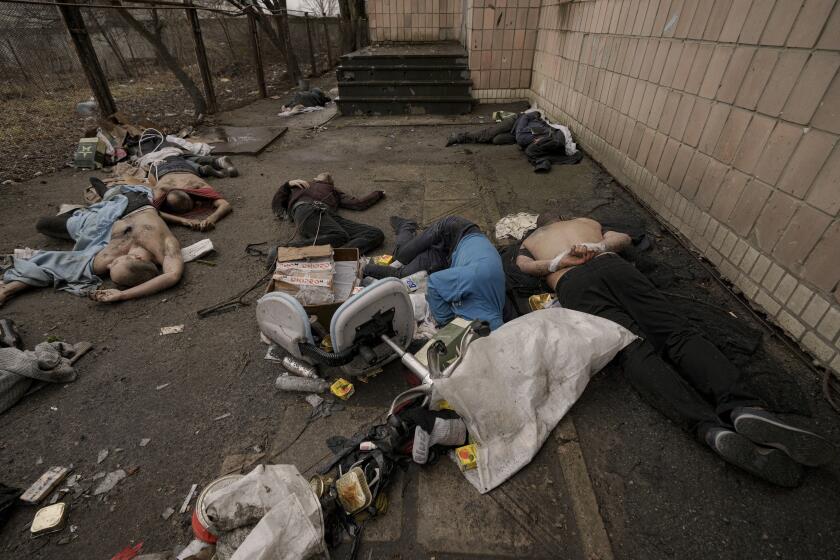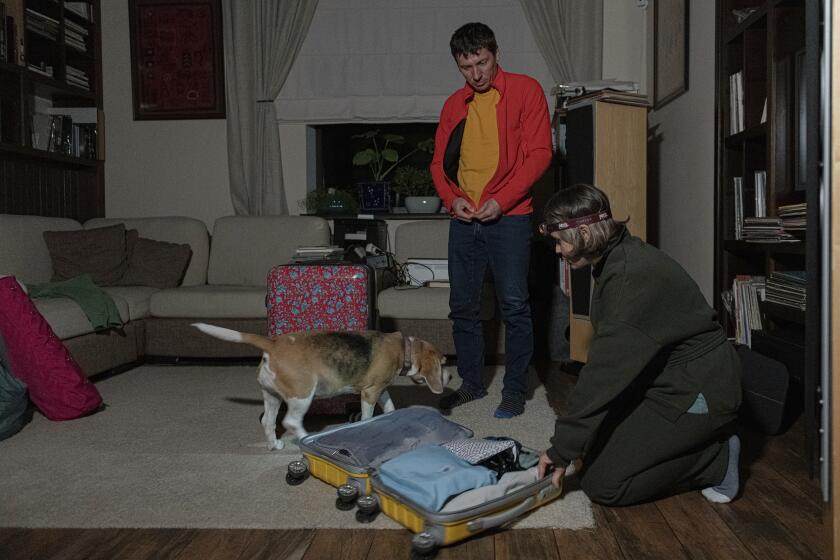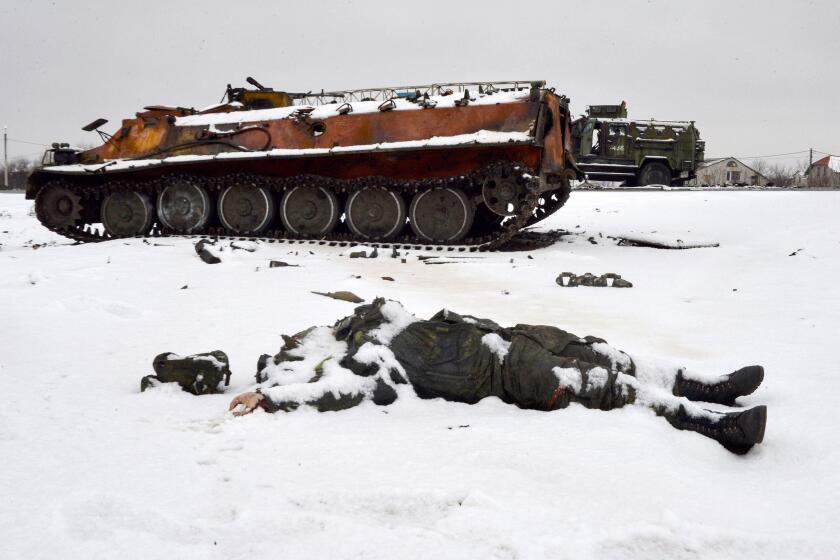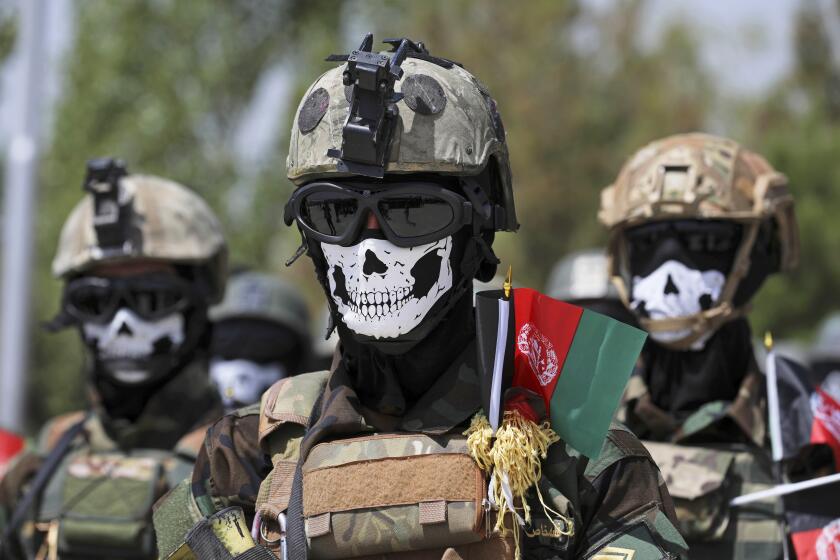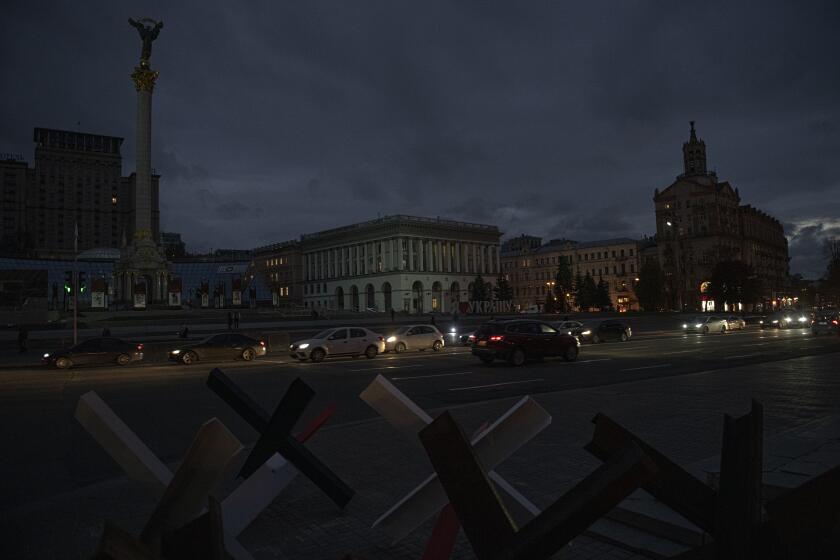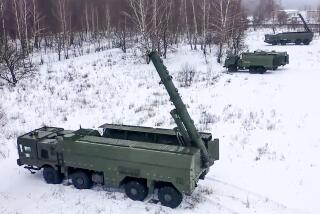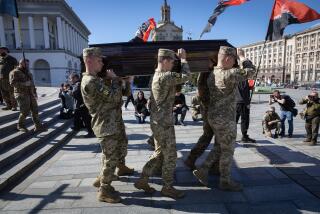Grit, dark humor and iodide pills: How Ukrainians are facing a nuclear threat
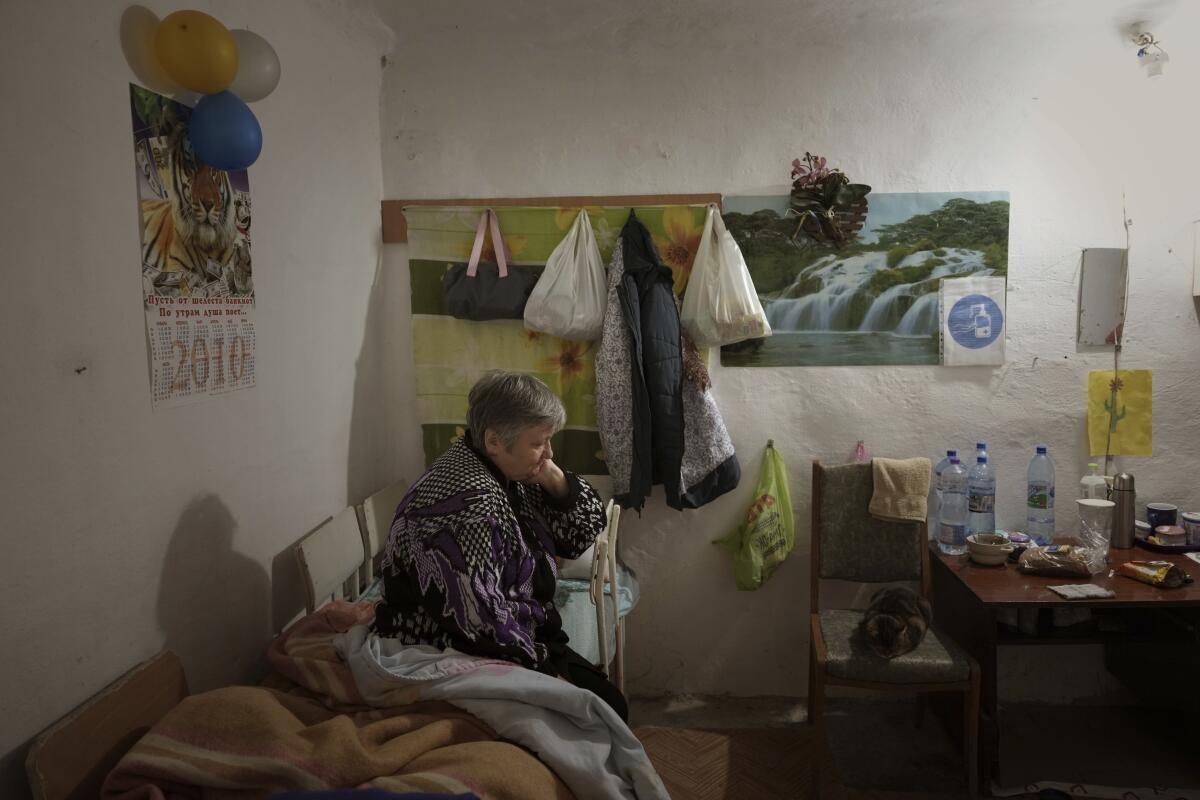
- Share via
KYIV, Ukraine — Dmytro Bondarenko is ready for the worst.
He’s filled the storage area under his fold-up bed and just about every other nook of his apartment in eastern Kyiv with water and nonperishable food. There are rolls of packing tape to seal the windows from radioactive fallout. He has a gas-fired camping stove and walkie-talkies.
There’s even an AR-15 rifle and a shotgun for protection, along with boxes of ammunition. Fuel canisters and spare tires are stashed by his washing machine in case he needs to leave the city in a hurry.
“Any preparation can increase my chance to survive,” he said, wearing a knife and a first-aid kit.
With the Russian invasion in its ninth month, many Ukrainians no longer ask if their country will be hit by nuclear weapons. They are actively preparing for that once-unthinkable possibility.
Over dinner tables and in bars, people often discuss which city would be the most likely target or what type of weapon could be used. Many, like Bondarenko, are stocking up on supplies and making survival plans.
It was a cold, gray morning, March 4 in Bucha, Ukraine, when Russian soldiers embarked on a cleansing operation.
Nobody wants to believe it can happen, but it seems to be on the mind of many in Ukraine, which saw the world’s worst nuclear accident at Chernobyl in 1986.
“Of course Ukraine takes this threat seriously, because we understand what kind of country we are dealing with,” presidential advisor Mykhailo Podolyak said, referring to Russia.
The Kremlin has made unsubstantiated claims that Ukraine is preparing a “dirty bomb” in Russian-occupied areas — an explosive to scatter radioactive material and sow fear. Kyiv vehemently denied it and said such statements were more likely a sign that Moscow was itself preparing to set off such a bomb and to blame it on Ukraine.
The nuclear fears trigger painful memories in those who lived through the Chernobyl disaster, when one of four reactors exploded and burned, releasing a plume of radiation. Soviet authorities initially kept the accident secret, and while the town near the plant was evacuated, Kyiv — only about 60 miles south — was not.
Ukrainian mayors, civilian administrators and nuclear power plant workers say they have been abducted, threatened or beaten by Russian forces.
The capital is now preparing for the release of radioactivity from a nuclear weapon, with more than 1,000 personnel trained to respond, said Roman Tkachuk, head of Kyiv’s Municipal Security Department. It has bought a large number of potassium iodide pills and protective equipment for distribution, he added.
With all the high-level warnings from Moscow, Washington and Kyiv about atomic threats, Ukrainians’ conversations these days are studded with phrases like “strategic and tactical nuclear weapons,” “potassium iodide pills,” “radiation masks,” “plastic raincoats” and “hermetically sealed food.”
Bondarenko said he started making nuclear survival plans when Ukraine’s Zaporizhzhia nuclear power plant — the largest in Europe — was affected by Russian attacks.
The 33-year-old app designer figures he’s got enough supplies to survive for a couple of weeks and more than enough fuel to leave the country or move deep into the mountains if nuclear disaster strikes.
Inspectors from the United Nations’ nuclear power agency are scrutinizing two sites in Ukraine where Russia alleges that ‘dirty bombs’ are being made.
He moved from the eastern Donetsk region several years ago after it was threatened by pro-Moscow separatists. He hoped for a calm life in Kyiv, but the COVID-19 pandemic forced a more isolated life in his apartment, and the war accelerated his survival plans.
His supplies include more than 50 gallons of water, potassium iodide pills to protect his thyroid from radiation, respirator face masks and disposable booties to guard against contaminated soil.
Bondarenko said he can’t be sure he would be safe from a Russian nuclear strike but believes it’s better to be prepared because “they’re crazy.”
Websites offer tips for surviving a dirty bomb, while TikTok has multiple posts of people packing “nuclear luggage” to make a quick getaway and offering advice on what to do in case of a nuclear attack.
Start your day right
Sign up for Essential California for the L.A. Times biggest news, features and recommendations in your inbox six days a week.
You may occasionally receive promotional content from the Los Angeles Times.
October has seen “huge spikes” of Ukrainian visits to Nukemap, a website that allows users to simulate an atomic bomb dropped on a given location, according to its creator, Alex Wellerstein.
The anxiety has prompted dark humor. More than 8,000 people joined a chat on the Telegram messaging service after a tweeted joke that, in case of a nuclear strike, survivors should go to Kyiv’s Schekavytsia Hill for an orgy.
On the serious side, mental health experts say having a support network is key to remaining resilient during uncertain times.
“You need to have the feeling that you can cope with this. And there is this group feeling [that is] quite strong,” said Dr, Koen Sevenants, lead for mental health and psychosocial support for global child protection for UNICEF.
Two Siberian journalists reporting on the war in Ukraine say they won’t be muzzled. ‘This is what we are supposed to do.’
However, he said extended periods under threat can lead to a sense of helplessness, hopelessness and depression. While a level of normalization can set in, that can change when threats increase.
Those living near the war’s front line, like the residents of Mykolaiv, say they often are too exhausted to think about new threats, since they have endured almost constant shelling. The city 310 miles south of Kyiv is the closest to Kherson, where battles are raging.
“Whether I believe it or not, we must prepare” for the nuclear threat, the head of the regional administration, Vitaliy Kim, told the Associated Press. He said regional officials were working on various scenarios and mapping evacuation routes.
More than half the prewar population of 500,000 has fled Mykolaiv. Many who stayed, like 73-year-old Valentyna, say they are too tired to leave now.
Afghan special forces soldiers who were trained by the U.S. and fled after the U.S. withdrawal are being recruited by Russia to fight in Ukraine.
She sleeps in a windowless basement shared with about 10 other neighbors in conditions so humiliating that she asked not to be fully identified. Of the threat of a nuclear attack, she says: “Now I believe that everything can happen.”
Another woman in the shelter, who wanted to be identified only as Tamara for the same reasons, said that while trying to sleep at night on a bed made from stacked wooden beams, her mind turns to what fate awaits her.
“During the First World War, they fought mainly with horses. During the Second World War, with tanks,” she said. “No one excludes the possibility that this time it will be a nuclear weapon.
“People progress, and with it, the weapons they use to fight,” she added. “But man does not change, and history repeats itself.”
Rolling blackouts are increasing across Ukraine as the government rushes to stabilize the energy grid and repair systems damaged by Russian attacks.
In Kyiv, Svitlana Bozhko, 62, feels that same fatigue. She has learned what to do in case a missile hits, keeps a supply of remedies for various kinds of chemical attacks and has what she calls her “anxiety luggage” — essentials packed in case of sudden evacuation.
“I’m so tired of being scared — I just keep living my life,” she says. “But if something happens, we will try to fight and survive.”
And she said she understands the difference between 1986 — the year of the Chernobyl disaster, the likes of which she hoped never to go through again — and 2022.
“Back then, we were afraid of the power of atoms. This time, we face a situation when a person wants to exterminate you by any means,” Bozhko said, “and the second is much more terrifying.”
More to Read
Sign up for Essential California
The most important California stories and recommendations in your inbox every morning.
You may occasionally receive promotional content from the Los Angeles Times.
